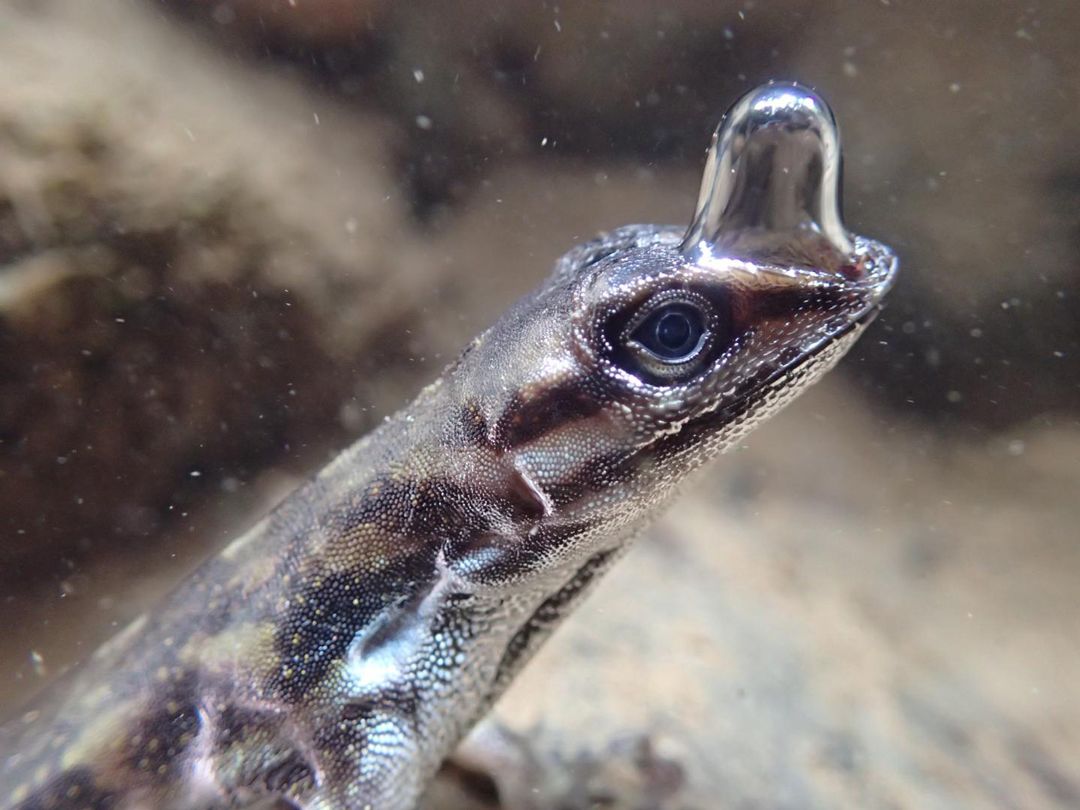Scuba-diving lizards and spots on Jupiter: May’s best science images
The month’s sharpest science shots, selected by Nature’s photo team.

Scuba divers. Evolutionary biologists have found that several semi-aquatic species of Anolis lizard have adapted to rebreathe exhaled air underwater using a bubble that clings to their snout. The technique allows them to stay underwater for more than 15 minutes, hiding from predators.

Credit: University of Oregon
Credit: University of Oregon
Building a brain. This microscope image shows a neural stem cell — the largest, brightest cell, towards the right of the image — from a Drosophila fruit fly. The cell’s progeny trail to the left in a cluster resembling a bunch of grapes. Fluorescent markers have been embedded in the cells’ membranes, so researchers can see how they divide. Such high-resolution imaging has captured the mechanical motions that the fly’s stem cells go through to make neurons in the developing brain. “We discovered that stem cells have more in common with real machines on a factory floor than previously appreciated, in that they undergo a mechanical cycle when producing each neuron,” says Ken Prehoda, a biochemist at the University of Oregon in Eugene.

Lost village. The eruption of Mount Nyiragongo in the Democratic Republic of the Congo saw buildings in several villages — including Bushara, shown here — engulfed in fast-moving lava. Nyiragongo sits on the East African Rift, where two tectonic plates are being pulled apart, allowing molten rock to rise to the surface. On 22 May, parts of the active volcano cracked open without warning, and streams of red-hot lava spilled out. The eruption destroyed houses and health-care centres near the city of Goma, and led to the deaths of more than a dozen people.

Credit: Chip Somodevilla/Getty
Credit: Chip Somodevilla/Getty
Brood X. May saw billions of periodical cicadas emerge in the eastern United States after living underground for 17 years. The insects, part of the Brood X or Great Eastern Brood emergence, appear in huge numbers for a few weeks to moult, mate, lay eggs and die — a strategy that allows the brood to survive predation. The next major Brood X emergence is predicted to happen in 2038.

Credit: Diana Trepkov/University of Waterloo
Credit: Diana Trepkov/University of Waterloo
Ill-fated expedition. This is a facial reconstruction of John Gregory, the first sailor from John Franklin’s doomed 1845 expedition to find the Northwest Passage whose remains have been identified by genealogical sleuthing. Researchers matched DNA from Gregory’s remains, found in what is now the Nunavut territory of Canada, with DNA from a living descendant in South Africa. “Having John Gregory’s remains being the first to be identified via genetic analysis is an incredible day for our family, as well as all those interested in the ill-fated Franklin expedition,” said Gregory’s great-great-great grandson, Jonathan Gregory. “The whole Gregory family is extremely grateful to the entire research team for their dedication and hard work, which is so critical in unlocking pieces of history that have been frozen in time for so long.”
Spots on Jupiter. Three very different portraits of Jupiter taken by the Gemini North telescope in Hawaii and the Hubble Space Telescope show views of the planet at infrared (shown), visible and ultraviolet wavelengths of light.
The images show how viewing objects at different wavelengths allows astronomers to glean extra insights. Jupiter’s counter-rotating bands of clouds can be seen clearly in all three bands of the spectrum.
However, the Great Red Spot — a vast storm system in the southern hemisphere named for its appearance in visible light — can barely be seen at infrared wavelengths, and looks strikingly different in ultraviolet (shown), appearing as a dark region slightly larger than in the visible-light image.
Credit: NASA/ESA/NOIRLab/NSF/AURA/M.H. Wong and I. de Pater (UC Berkeley) et al.

Credit: Judith Holford/Alamy
Credit: Judith Holford/Alamy
Collapsed arch. Darwin’s Arch, a memorable rock formation in the Galapagos archipelago named after Charles Darwin, collapsed on 17 May. The cause, according to Ecuador’s environment ministry, was natural erosion. The formation, which remains as two pillars, is a popular diving location, where visitors have observed sharks and other marine life.

Credit: Héctor Barrera/Ecuador’s Ministry of Environment
Credit: Héctor Barrera/Ecuador’s Ministry of Environment